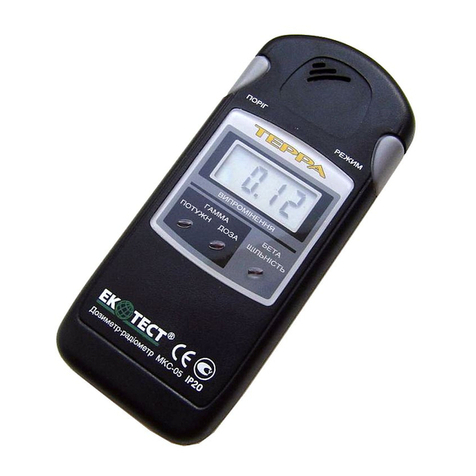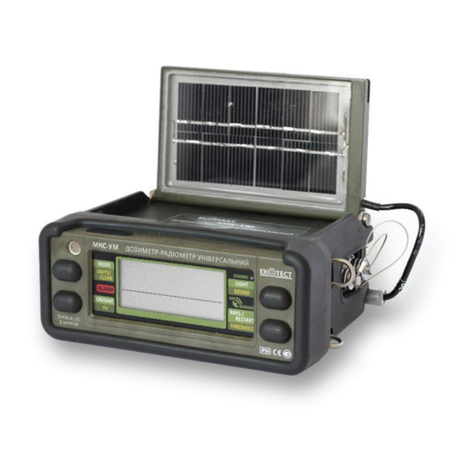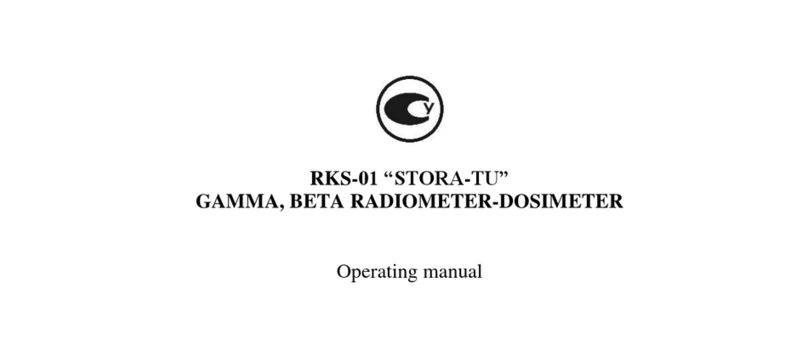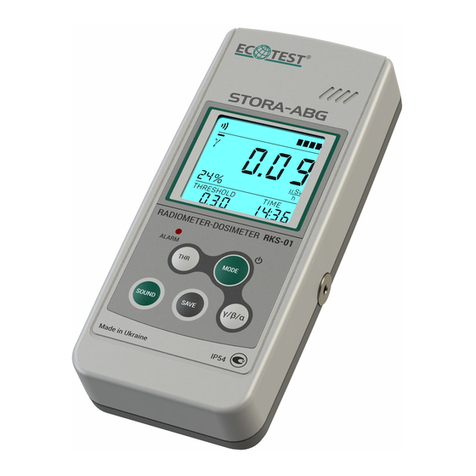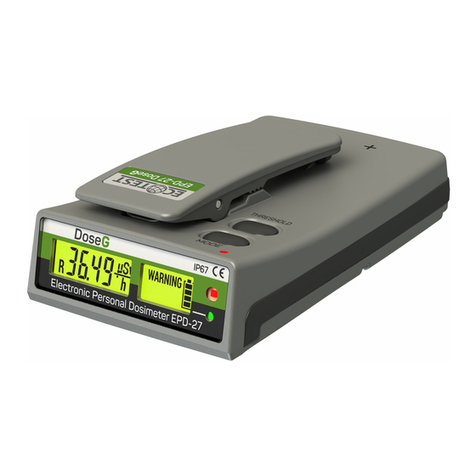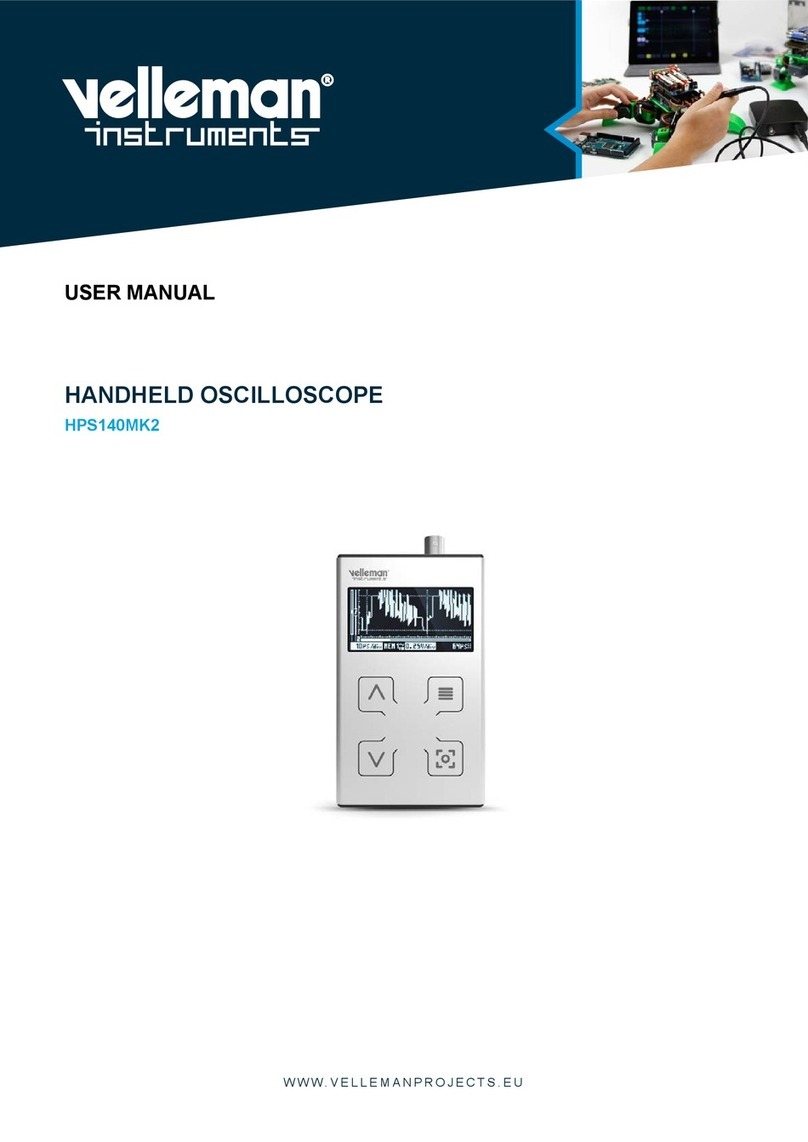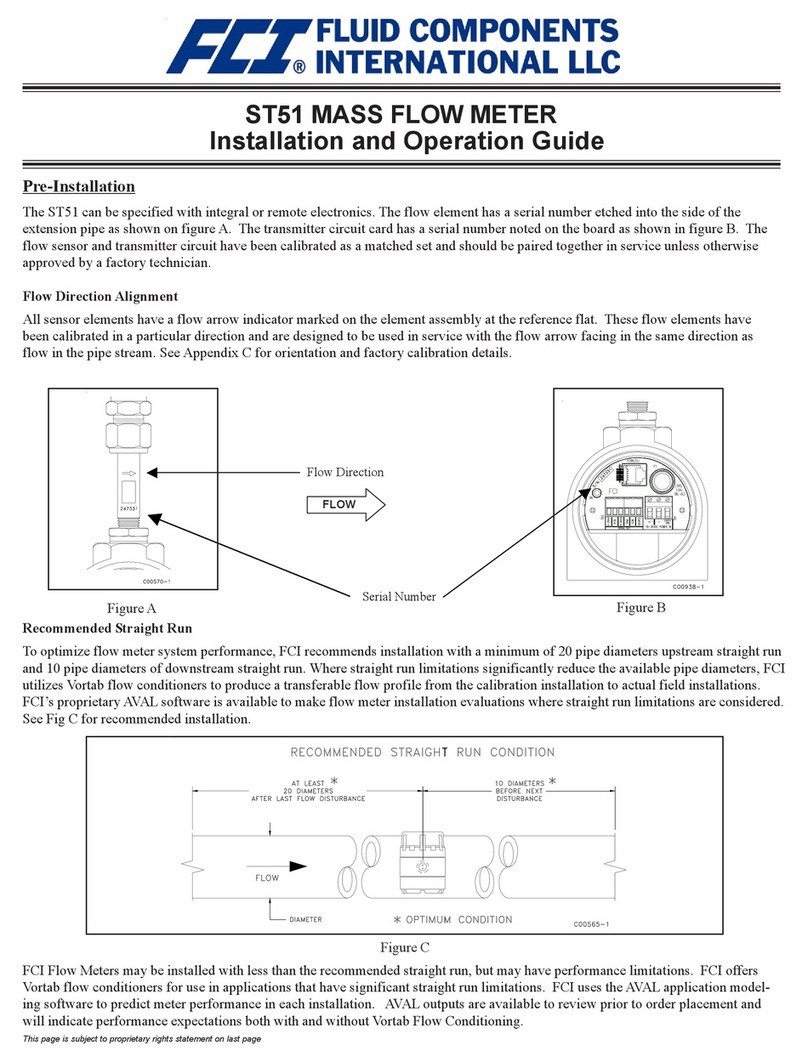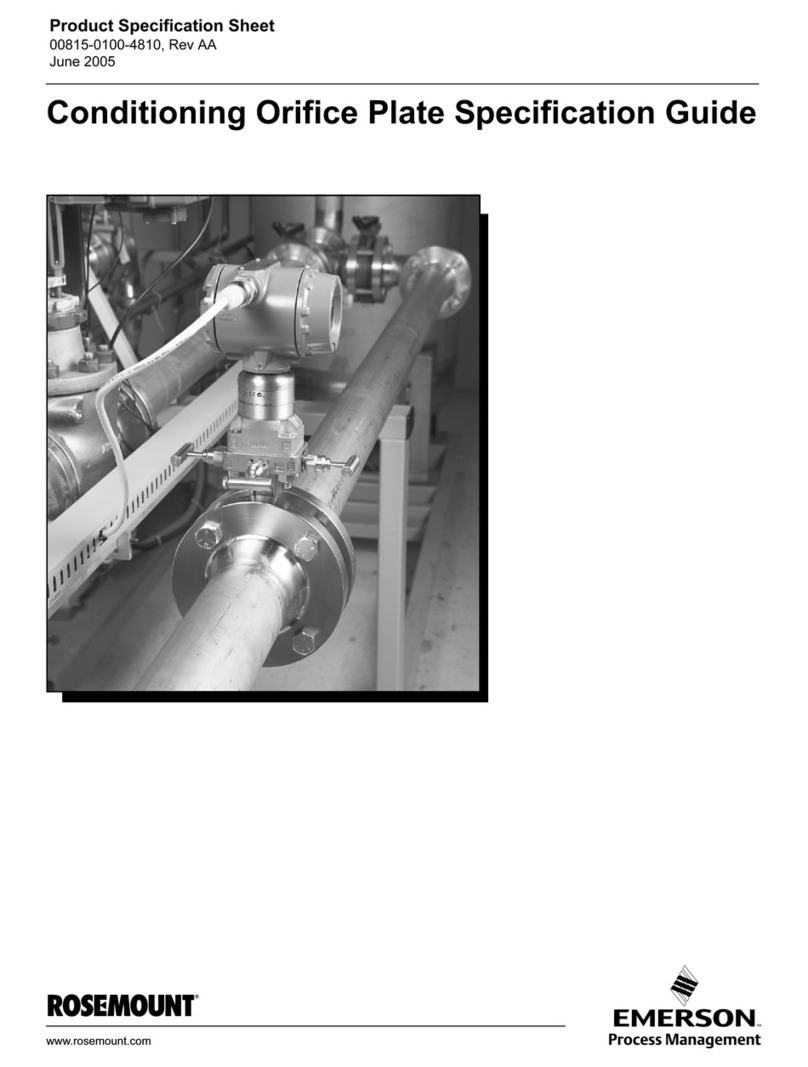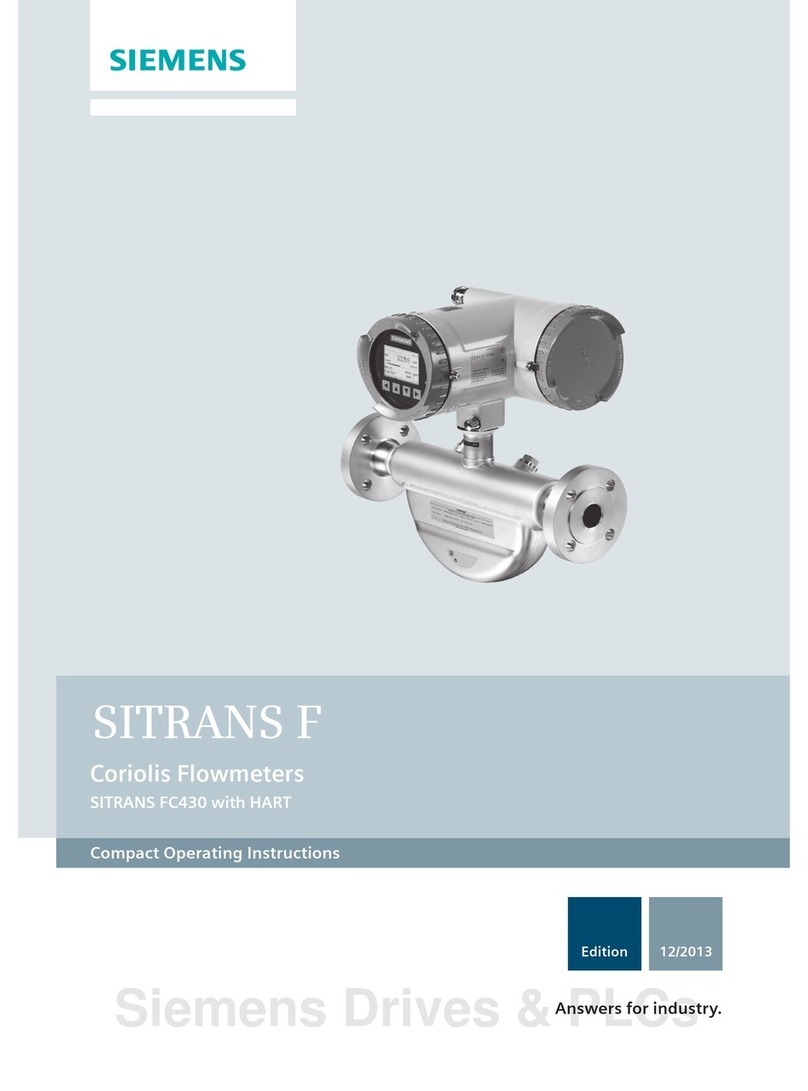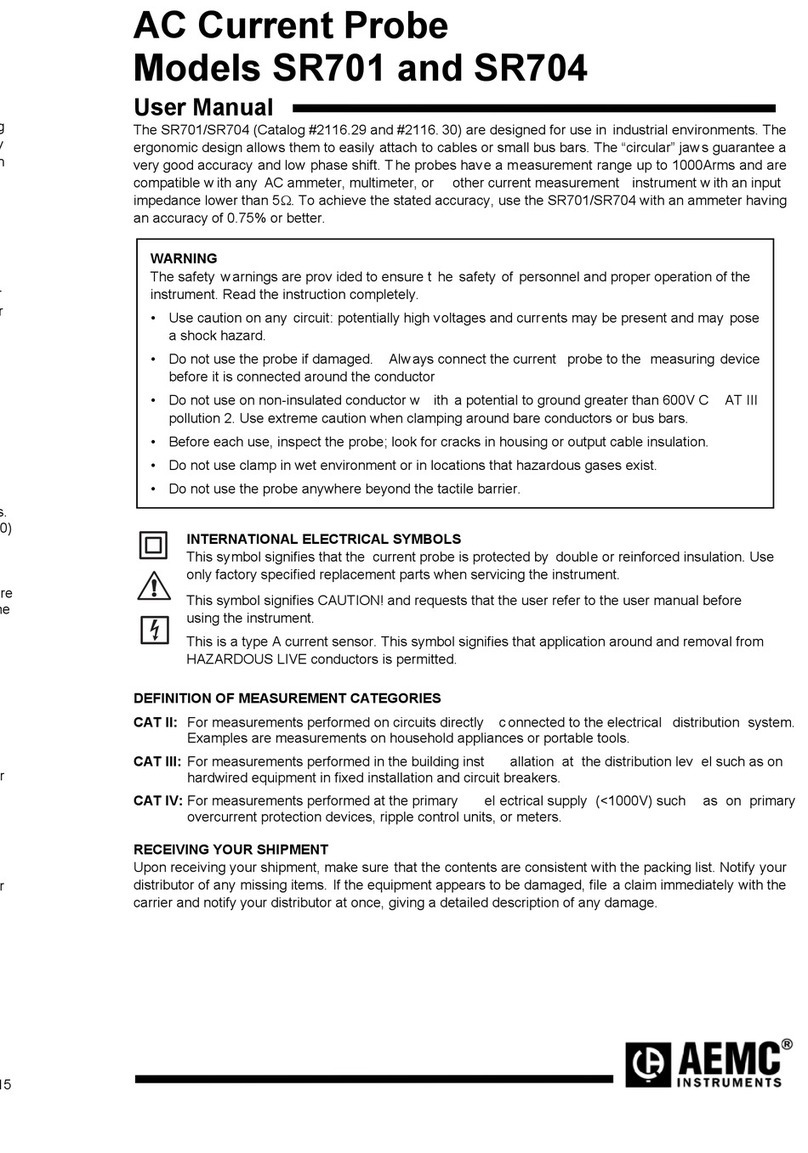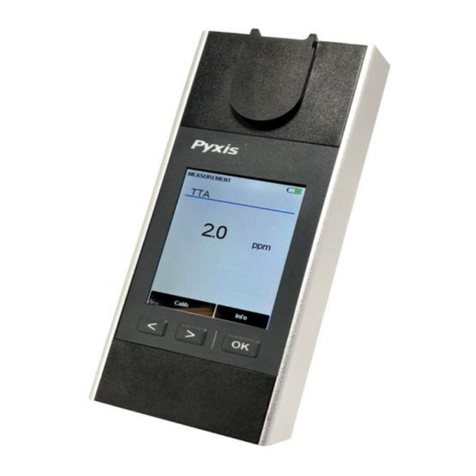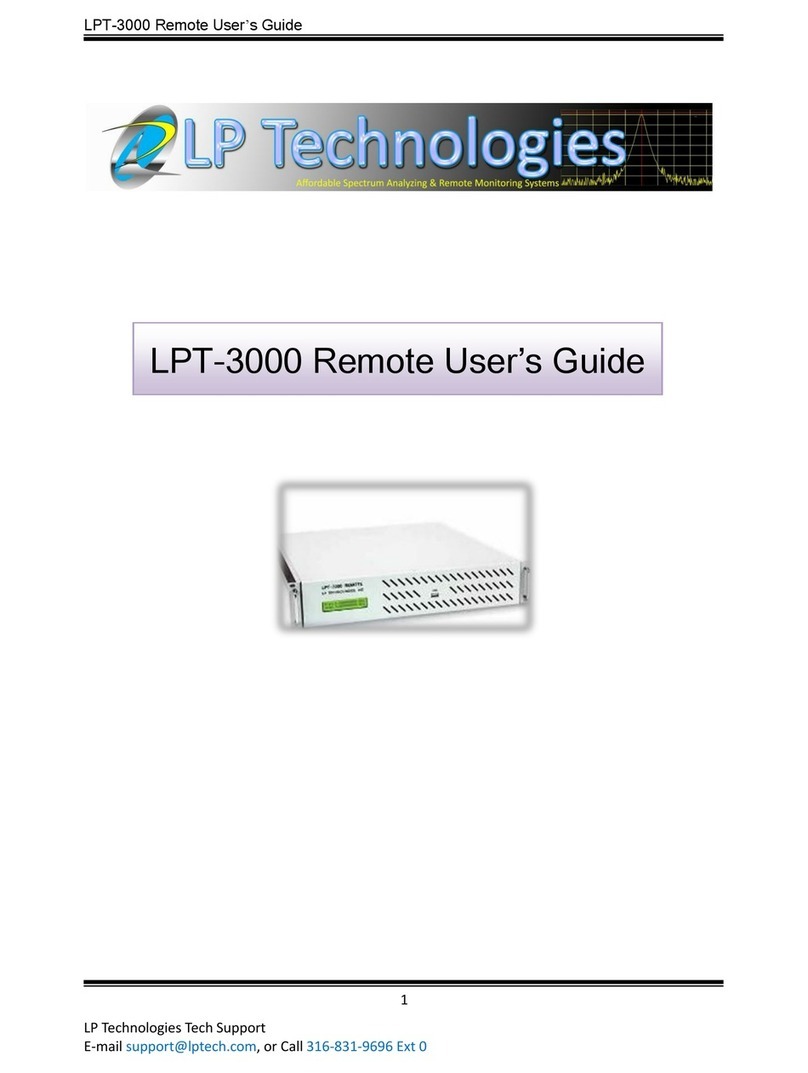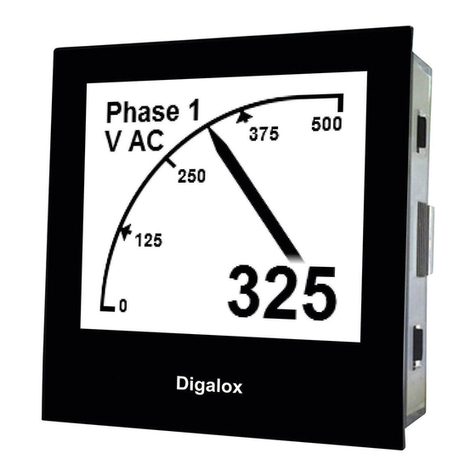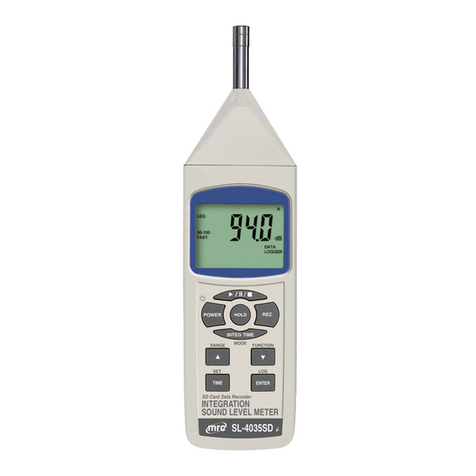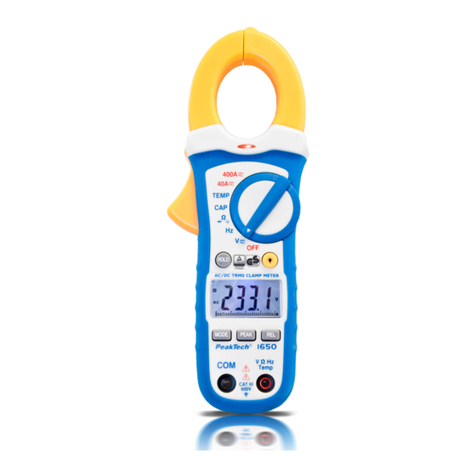ECOTEST PRD GUARDER DKG-24 User manual

“PRD GUARDER”
PERSONAL RADIATION DOSIMETER DKG-24
ВIСТ.412139.009-02 НЕ
Operating Manual


1
CONTENTS
1 DESCRIPTION AND OPERATION.................................... 3
1.1 PURPOSE OF USE OF THE DOSIMETER ............................... 3
1.2 TECHNICAL SPECIFICATIONS ........................................... 4
1.3 DELIVERY KIT OF THE DEVICE........................................11
1.4 DESIGN AND PRINCIPLE OF OPERATION ..........................12
1.5 LABELING AND SEALING.................................................14
1.6 PACKING ........................................................................14
2 PROPER USE OF THE DEVICE........................................15
2.1 OPERATING LIMITATIONS ...............................................15
2.2 PREPARATION FOR OPERATION.......................................15
2.3 USE OF THE DEVICE ........................................................16
3 TECHNICAL MAINTENANCE.........................................45
3.1 TECHNICAL MAINTENANCE OF THE DEVICE ....................45
3.2 VERIFICATION OF THE DEVICE........................................46
4 CERTIFICATE OF ACCEPTANCE ...................................47
5 PACKING CERTIFICATE..................................................48
6 WARRANTY.......................................................................49
7 REPAIR................................................................................50
8 STORAGE ...........................................................................51
9 TRANSPORTATION..........................................................52
10 DISPOSAL.........................................................................53
ANNEX А...............................................................................54
ANNEX B...............................................................................55
ANNEX C...............................................................................56
ANNEX D...............................................................................57
ANNEX E ...............................................................................58
ANNEX F................................................................................59

2
This operating manual (hereinafter referred to as the OM)
is intended to inform the user about the principle of operation of
the DKG-24 “PRD GUARDER” personal radiation dosimeter,
the procedure for working with it, and contains all the
information necessary for the full use of its technical capabilities
and its correct operation.
The OM contains the following abbreviations and
designations:
DER –ambient dose equivalent rate of gamma and X-ray
radiation (hereinafter referred to as photon ionizing radiation);
DE –ambient dose equivalent of gamma and X-ray
radiation (hereinafter –photon ionizing radiation);
HSSDU –high sensitivity scintillation detecting unit of
photon ionizing radiation;
LSSDU –low sensitivity scintillation detecting unit of
photon ionizing radiation;
PC –a personal computer.

3
1 DESCRIPTION AND OPERATION
1.1 Purpose of use of the dosimeter
DKG-24 “PRD GUARDER” Personal Radiation
Dosimeter (hereinafter referred to as the device) is intended for:
•search for (detect and localize) radioactive and nuclear
materials by their external gamma radiation;
•measurement of photon ionizing radiation DER;
•measurement of photon ionizing radiation DE;
•determining the intensity of photon ionizing radiation
The device can be used to control unauthorized
movements of radioactive materials and search for sources of
radioactive radiation, as well as at enterprises and institutions
that deal with sources of photon ionizing radiation.
The device can be used in the following areas:
•customs and border service;
•military and security services (Ministry of Internal
Affairs, Security Service of Ukraine, guard services);
•metallurgy and scrap metal procurement;
•monitoring of vehicles, seaports and airports;
•environmental inspections;
•radioactive waste repositories.

4
1.2 Technical specifications
1.2.1 The main technical data and specifications are
provided in Table 1.1.
Table 1.1
Specification
Unit of
measure
Standardized values
The general range of indica-
tion and measurements of
photon ionizing radiation
DER:
- indications
- measurements from HSSDU
- measurements from the
LSSDU
μSv/h
from 0.01 to 107
from 0.01 to 50
from 50 to 107
The general range of indica-
tion and measurements of
photon ionizing radiation DE:
- indications
- measurements
μSv
from 0.1 to 9.9·106
from 1.0 to 9.9·106
The indication range of
photon ionizing radiation
counting rate
cps
from 1 to 1000000
Main relative permissible
error limit when measuring
photon ionizing radiation
DER with a confidence
probability of 0.95 (137Cs)
- in the range from
0.01 μSv/h to 1.0 μSv/h
- in the range from 1.0 μSv/h
to 107μSv/h
%
15+2/М,
where M is a
dimensionless
value that is
numerically equal
to the DER value
measured in μSv/h
15

5
Table 1.1 (continued)
Specification
Unit of
measure
Standardized
values
Main relative permissible error limit
when measuring photon ionizing
radiation DE with a confidence
probability of 0.95 (137Cs)
%
15
Energyrange of photon ionizing
radiation being detected
MeV
from 0.02
to 10.0
Energydependence of the device
readings when measuring photon
ionizing radiation DER and DE in the
energyrange from 0.05 MeV to
3.00 MeV relative to the energy of
0.662 MeV (137Cs)
%
±25
Anisotropy for HSSDU and LSSDU
detectors when gamma radiation falls on
them in directions at angles from +60 to
minus 60oin the horizontaland vertical
planes relative to the main measurement
direction, marked with “+” symbol,
should notexceed:
- for isotopes 137Cs and 60Co
- for 241Am isotopes
%
30
75
Time of operating mode setting of the
device, no more
min
1
Calibration time by gamma background
level
s
from 10 to
90
The response time to over ten-fold chan-
ge inphoton ionizing radiation DER
s
0,25
Rated supply voltage of the device from
two galvanic cells (AA):
- lithium and alkaline
- nickel metal hydride batteries
- from the USB port
V
3,0
2,4
5,0

6
Table 1.1 (continued)
Specification
Unit of
measure
Standardized
values
Time of continuous operation
of the device when powered
under the conditions of gamma
radiation background of no
more than 0.5 μSv/h:
- with the display backlight
turned off, the alarm not
activated, the navigation
receiver and Bluetooth turned
off, no less than:
- for two new FR6 type lithium
batteries or two new Energizer
Max E91 alkaline batteries;
- for two new, fully charged
nickel-metal-hydride batteries
with a capacity of 2700 mAh;
- with the display backlight
turned off, the alarm not
activated, the navigation
receiver and Bluetooth turned
on, no less than:
- for two new FR6 type lithium
batteries or two new Energizer
Max E91 alkaline batteries;
- for two new, fully charged
nickel-metal-hydride batteries
with a capacity of 2700 mAh
hour
400
300
55
40
Operating temperature range
°С
from -20 to
+60
Overall dimensions of the
device without a case, no more
mm
60×110×30
Weight of the device, no more
kg
0,21

7
1.2.2 Sensitivity to photon ionizing radiation for 137Cs of
the applied scintillation detector CsI(TI) with a volume of 9 cm3,
not less than 200 (cps)/(μSv/h).
1.2.3 The threshold alarm system with three independent
threshold levels is implemented in the device:
- the threshold level of the pulse counting rate from the
detector of photon ionizing radiation (search threshold level or
sigma threshold);
- threshold level of photon ionizing radiation DER (safety
threshold level);
- threshold level by photon ionizing radiation DE
(threshold level by the accumulated dose).
1.2.3.1 The search threshold level is calculated by the
device automatically in the calibration mode according to the
intensity level of the gamma background and consists of the
background counting rate and the programmed number of root
mean square deviations of the background counting rate. The
calibration time for the gamma background intensity level is
from 10 s to 90 s.
The programming range of the number of root mean square
deviations is from 1.0 to 10.0. The programming resolution is
0.1. When the search threshold level is exceeded, the device
signals with light (red) and/or vibration and/or sound signals
“Sigma threshold exceeding”. Any combination of alarms is
possible, while turning off all types of alarms is impossible. The
alarm is duplicated by the corresponding icon on the device’s
display.
The threshold alarm of the device when the search
threshold level is exceeded is triggered no later than 2 s after the
increase in the level of photon ionizing radiation from the
background value (with the level of photon ionizing radiation
DER of 0.1 μSv/h) to the DER level of 0.5 μSv/h during no more
than 0.5 s.
The alarm about exceeding the search threshold level can
be disabled if the number of root mean square deviations is set
to the “Off” state.

8
1.2.3.2 The safety threshold level is programmed in
XXX,YY format in μSv/h or mSv/h. The minimum safety
threshold level can be at least 0.3 μSv/h. When this threshold
level is exceeded, the device signals with a light (red), vibration
or sound signal “Safety threshold exceeding”. Any
combination of alarms is possible, while turning off all types of
alarms is impossible. The alarm is duplicated by the
corresponding icon on the device’s display.
1.2.3.3 The accumulated dose threshold level is
programmed in XXX,Y format in μSv and mSv, and in X,YYY
format in Sv. The DE threshold level can be set to 0, while the
alarm on exceeding the DE threshold level will be disabled.
Otherwise, when the DE threshold level is exceeded, the device
signals with a light (red), vibration and sound signal
“Accumulated dose threshold level exceeding”. Any
combination of alarms is possible, while turning off all types of
alarms is impossible. The alarm is duplicated by the
corresponding icon on the device’s display.
1.2.4 The frequency of false alarms for photon ionizing
radiation is no more than 1 per 10 hours when working in a stable
background environment and the following threshold values:
- search –5;
- safety –1 μSv/h;
1.2.5 The device implements the possibility of automatic
keeping an event log in the non-volatile memory, namely:
- turning on the device;
- turning off the device;
- exceeding the search threshold level;
- exceeding the safety threshold level;
- exceeding the accumulated dose threshold level;
- saving the measurement at the user’s command;
- saving the measurement after a set period of time or a set
distance;
- erasing the device’s flash memory.
1.2.6 The volume of non-volatile memory allows storing up
to 65536 records of the registered event.

9
1.2.7 Information exchange between the device and a
personal computer (hereinafter –PC) takes place via USB. It is
possible to operate the device from an external power source via
a USB cable.
1.2.8 Information exchange between the device and a mobile
phone based on Android OS is carried out via a Bluetooth
connection.
1.2.9 The device displays signs of low batteries.
1.2.10 The device ensures operability under the following
conditions:
- ambient temperature from minus 20 оСto 60 оС;
- relative humidity up to 98% at a temperature of 35 оС, non-
condensing;
- atmospheric pressure from 84 kPa to 106.7 kPa.
1.2.11 The device is resistant to (when on) the influence of
sinusoidal vibrations in the frequency range from 10 Hz to 55 Hz
with a displacement amplitude of 0.15 mm.
1.2.12 The device is resistant to (when on) single shocks
with the following parameters:
- the shock pulse duration –6 ms;
- maximum shock acceleration –50 m/s2.
1.2.13 The device is resistant to (when on) drops on each
of the six sides from a height of 0.75 m.
1.2.14 The device is resistant to (when on) the influence of
a continuous or alternating magnetic field with a frequency of
(50 1) Hz and a strength of 400 A/m.
1.2.15 The device is resistant to (when on) the influence of
photon ionizing radiation corresponding to DER up to 100 Sv/h
for 5 min.
1.2.16 The ingress protection rating of the device in
compliance with DSTU EN 60529:2018 –is IP67.
1.2.17 The device meets the electromagnetic compatibility
requirements of DSTU EN 61326-1:2016 standard for group 1,
class B equipment.

10
1.2.17.1 The device is immune to the effects of electrostatic
discharges according to DSTU EN 61000-4-2:2008 standard
under the impact of a contact discharge of 6 kV and an air
discharge of 8 kV.
1.2.17.2 The device is immune to the influence of
electromagnetic fields of the radio frequency range according to
DSTU IEC 61000-4-3:2007 standard in the frequency range
from 80 MHz to 1000 MHz at a voltage of 10 V/m (test level 3).
1.2.17.3 The quasi-peak value of the radio interference
field strength of the device does not exceed the standards for
class B group 1 equipment according to DSTU EN 55011:2017
standard (DSTU CISPR 11:2017).
1.2.18 With regard to electrical equipment safety the
device meets the requirements of DSTU EN 61010-1:2014
standard.
1.2.19 Mean time to failure –is not less than 6,000 hours.
1.2.20 The average first overhaul period is not less than
10,000 hours.
1.2.21 The average life of the device is not less than
10 years.
1.2.22 The average shelf life of the device is not less than
10 years.
1.2.23 The average time to restore the device, excluding
the time of delivery of spare parts and metrological calibration,
is no more than 3 hours.

11
1.3 Delivery kit of the device
1.3.1 The device’s delivery kit includes products and
operating documentation listed in Table 1.2.
Table 1.2 –Delivery kit
Item
Type
Quan-
tity
Note
Personal
Radiation
Dosimeter
DKG-24
“PRD
GUARDER”
ВІСТ.412139.009-02
1
Connecting
cable (USB
shielded)
1
Model is not
specified
Operating
manual
ВІСТ.412139.009-02
HE
1
“Spectra
Reader”
Software
ВІСТ.00025
1
On a mini CD
Housing
ВІСТ.323364.001
1
2.5 mm hex
L-shaped key
AGAS2E06
TOPTUL
Screwdriver
Case
1
Model is not
specified
Note. The device is supplied with two alkaline batteries.
Nickel-metal hydride batteries and a charger for charging them
are supplied optionally.

12
1.4 Design and principle of operation
1.4.1 General information, design description
1.4.1.1 Appearance of the device is shown in Figure 1.
Figure 1 –Appearance of the device
In terms of design, the device’s shape is a derivative of a
rectangular parallelepiped with the replacement of planes by
surfaces with large radii of curvature with rounded edges. The
plastic body is dust- and moisture-proof. The working position of
the device is vertical.
The ingress protection rating is IP67. The body consists of two
covers (1) and (2), connected together by screws. The front cover
(1) contains a graphic monochrome display (3), three control
buttons (4), GAMMA (7) and BATTERY (8) indicators.
The light panel (5) for signaling when a radioactive source
is detected is located in the upper part of the cover.
A USB connector for connecting peripheral devices is
placed on the back surface of the device case under a protective
elastic plug (6).

13
The device is powered by two batteries (AA size). It is
possible to operate it from lithium batteries –FR6 with a total
nominal voltage of 3.0 V, from alkaline batteries with a total
nominal voltage of 3.0 V and nickel-metal hydride batteries with
a total nominal voltage of 2.4 V. The device can also be powered
from a USB port with a nominal voltage of 5.0 V.
The device is sealed with paste in the recess of the bottom
cover.
1.4.2 Operation of the device
The device consists of the following main parts: high
sensitivity scintillation detecting unit of gamma radiation
(GSDUh), low sensitivity scintillation detecting unit of gamma
radiation (GSDUl), supply voltage formers (SVF), bias voltage
formers (BVF), GPS/GNSS receiver (NAV), BLE radio module,
display and processing module (DPM), graphical monochrome
display (GMD), batteries (B), thermal detector (TD).
GSDUh and GSDUl consist of a scintillation detector with
a silicon photomultiplier and an amplifier.
The principle of operation of the detecting units is based on
the transformation of scintillations caused by photon ionizing
radiation in the scintillator into voltage pulses in a
semiconductor photomultiplier. These pulses are fed to the input
of the amplifier where they become amplified and come to the
output as pulses of positive polarity. The number of these pulses
is proportional to photon ionizing radiation DER, and the
amplitude is proportional to the energy.
To ensure high temperature stability of the detectors with
silicon photomultiplier, the DPM carries out constant
temperature compensation by measuring the exact values of
temperature at the detectors, and precisely adjusts their bias
voltage.
DPM processes the pulse flows coming from the outputs of
GSDUh and GSDUl, and calculates the value of photon ionizing
radiation DER, which corresponds to these flows considering
the multichannel amplitude analysis, and the pulse count rate
from GSDUh and GSDUl. Depending on the operating mode of

14
the device, the GMD displays the readings of DER, flux
intensity, intensity flow histogram, statistical error by gamma
channels.
If photon ionizing radiation DER exceeds the value of
50 μSv/h, the GSDUh automatically turns off, and the DER
value is calculated from the GSDUl, which runs constantly. The
photon ionizing radiation DE is also calculated from the GSDUl.
The DPM consists of the non-volatile memory, which
stores entries of the events log.
1.5 Labeling and sealing
1.5.1 The upper cover and the panel of the device is
inscribed with the name and a symbol of the device, the ingress
protection rating and the manufacturer’s trademark.
1.5.2 The lower cover of the device contains the factory
serial number and the date of manufacture according to the
company’s numbering system.
1.5.3 Sealing of the device is performed by the
manufacturer.
1.5.4 Removal of seals and repeated sealing is performed
by the company after repair and calibration of the device.
1.6 Packing
1.6.1 The device in the housing, the connecting cable, the
hex key, the operating manual and the software on the mini CD
are placed in a dust- and moisture-proof case.
1.6.2 The case with the device kit placed in it is put in a
cardboard packing box, which is glued up on both sides with a
plastic film with a sticky layer. The box is placed in a
polyethylene cover, which is sealed. To reduce the cost of the
device, a cardboard packaging option can be used.

15
2 PROPER USE OF THE DEVICE
2.1 Operating limitations
Operating limitations are presented in Table 2.1.
Table 2.1 –Operating limitations
Operating limitation
Limitation parameters
Ambient air
temperature
below minus 20 and above 50 °C
Effect of photon
ionizing radiation
DER of photon ionizing radiation
is more than 100 Sv/h
2.2 Preparation for operation
2.2.1 Scope and order of external examination
2.2.1.1 Before using the device, unpack it and check if the
delivery kit is complete. Examine for mechanical damages.
2.2.2 Rules and order of examination for operational
readiness
2.2.2.1 Read this OM carefully before you start, and
examine the location and purpose of indicators and controls.
Note 1. The device is equipped with two AA galvanic cells.
There is no possibility of charging as part of the device.
Note 2. It is recommended to remove the galvanic cells
from the battery compartment before long-term storage of the
device.
2.2.3 List of possible troubles and troubleshooting
2.2.3.1 The list of possible troubles and troubleshooting is
presented in Table 2.2. Please record the possible troubles in the
table of Annex A of the Operating Manual.

16
Table 2.2 - List of possible troubles and troubleshooting
2.2.3.2 At failure to eliminate the troubles presented in
Table 2.2, or at detection of more complicated troubles, the
dosimeter should be sent for repair to the manufacturer.
2.3 Use of the device
2.3.1 Safety measures during use of the device
2.3.1.1 All works on the device use should be carried out
according to the requirements set out in the following
documents:
“Radiation Safety Standards of Ukraine” (NRBU-97).
State hygienic standards DHN 6.6.1-6.5.001-98,
“Basic Sanitary Rules of Radiation Safety of Ukraine”
(OSPU-2005) DSP 6.177-2005-09-02.
2.3.1.2 The device’s surface contains no voltages
hazardous for life.
2.3.1.3 The device meets the requirements of DSTU
7237:2011 and DSTU EN 61010-1:2014 standards in terms of
protection against electric shock.
Note. The class of protection against electric shock is not
determined due to the device’s external power supply voltage
being less than 60 V.
Trouble, its
manifestation and
additional features
Probable cause
Troubleshooting
The device does
not switch on
The device batteries
got discharged
Change the
batteries
No communication
between the device
and the personal
computer
USB cable damaged
USB sharing is not
allowed in the
device settings
Replace the USB
cable
Allow USB
sharing in device
settings

17
A special protective jacket is used to prevent accidental
contact with conductive parts.
Ingress protection rating is - IP67 according to DSTU EN
60529:2018.
2.3.1.4 Fire safety conditions are ensured by the fact that
the device belongs to compact electronic devices with low
energy consumption, and the absence of combustible materials
used in the structure, and the critical temperature is insufficient
for self-ignition.
2.3.1.5 Direct application of the device is not dangerous for
personnel and is environmentally friendly.
2.3.1.6 In the event of contamination, the device shall be
decontaminated by wiping its surfaces by a gauze swab moistened
with a standard decontaminating agent.
2.3.1.7 Disposal of the device shall be performed in
compliance with the Laws of Ukraine “On Environmental
Protection” and “On Waste", i.e. metal is recycled or melted, and
plastic parts are dumped.
2.3.2 Operating modes of the device
The device has the following modes:
- Switching on/off (2.3.3.1 - 2.3.3.2);
- Measurement and indication of photon ionizing radiation
DER (2.3.3.3);
- Intensity histograms display (2.3.3.4);
- Search diagram display (2.3.3.5);
- Measurement of photon ionizing radiation DE (2.3.3.6);
- Setting up the device (2.3.3.7);
- Mode of data communication with PC (2.3.3.8).
2.3.2.1 To control the operation of the device, according to
Figure 1, two navigation buttons “<”, “>” and the ENTER button
are used.

18
You can use the navigation buttons to change the operating
modes of the device, its settings, and navigate through the menu.
The ENTER button serves to save settings, confirm entered data,
recalibrate, switch on the device, as well as enter and exit the
software update mode.
2.3.2.2 A graphic monochrome display is used to control
the device operation.
2.3.2.3 During operation, the device generates the
following vibration-sound and light signals.
2.3.2.3.1 Vibration and sound signals:
“Quantum” –is a sequence of short beeps that indicate the
intensity of registered quanta of photon ionizing radiation. The
frequency of the signal is proportional to the count rate of photon
ionizing radiation quanta. Signal “Quantum” can be enabled or
disabled only in the mode of the intensity histogram display.
“Sigma threshold level exceeding” - periodic light, sound
and/or vibration signals, which indicate that the set intensity
threshold of photon ionizing radiation quanta count rate has been
exceeded. When the light and sound signals are turned off, the
frequency of the vibration signal will be proportional to the
count rate of photon ionizing radiation quanta.
“Safety threshold level exceeding” –periodic light,
sound and/or vibration signals generated when the measured
value of photon ionizing radiation DER is higher than the safety
threshold level.
“Exceeding the accumulated dose threshold level” –
periodic light, sound and/or vibration signals that are generated
if the measured DE value of photon ionizing radiation exceeds
the threshold level.
“Low battery” –periodic light, sound and/or vibration
signals that indicate a significant discharge of the device battery.
These signals can be completely disabled.
“Turning the device on/off” –polytonic sound, vibration
and light signals, which indicate that the device was switched on
or off. These signals can be completely disabled.
Table of contents
Other ECOTEST Measuring Instrument manuals
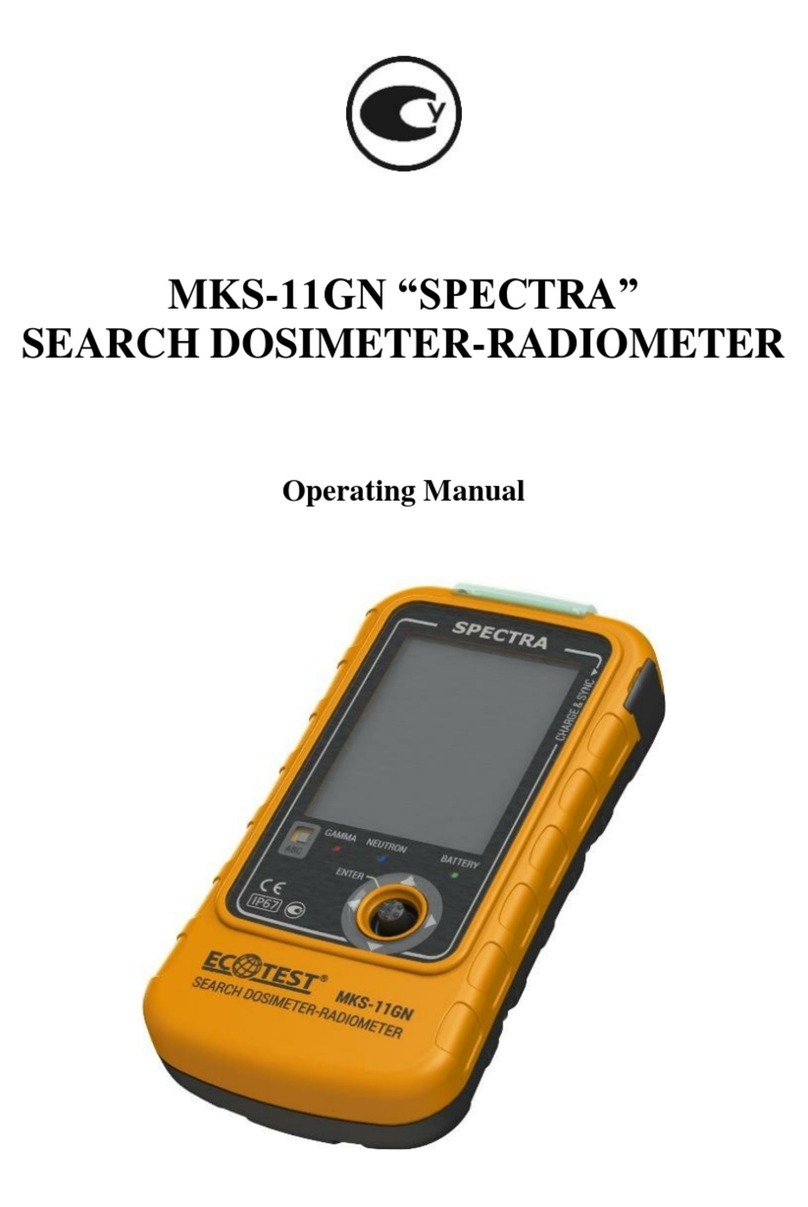
ECOTEST
ECOTEST SPECTRA MKS-11GN User manual
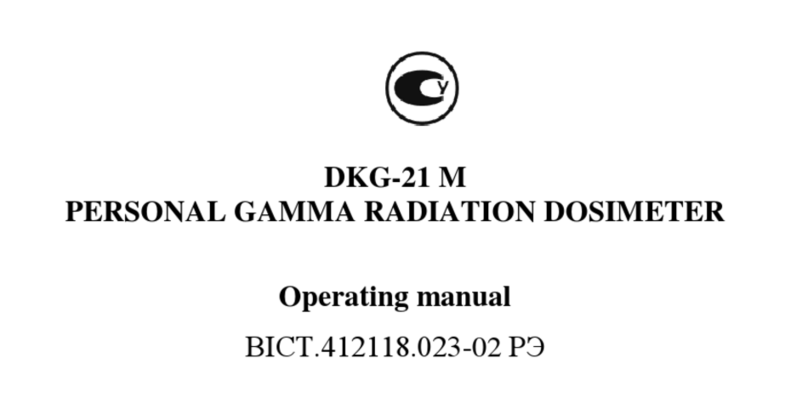
ECOTEST
ECOTEST DKG-21 M User manual
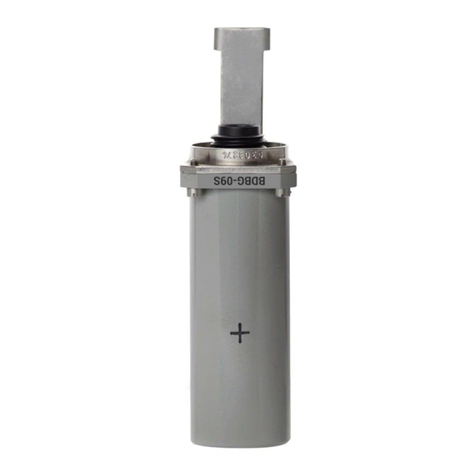
ECOTEST
ECOTEST BDBG-09S User manual
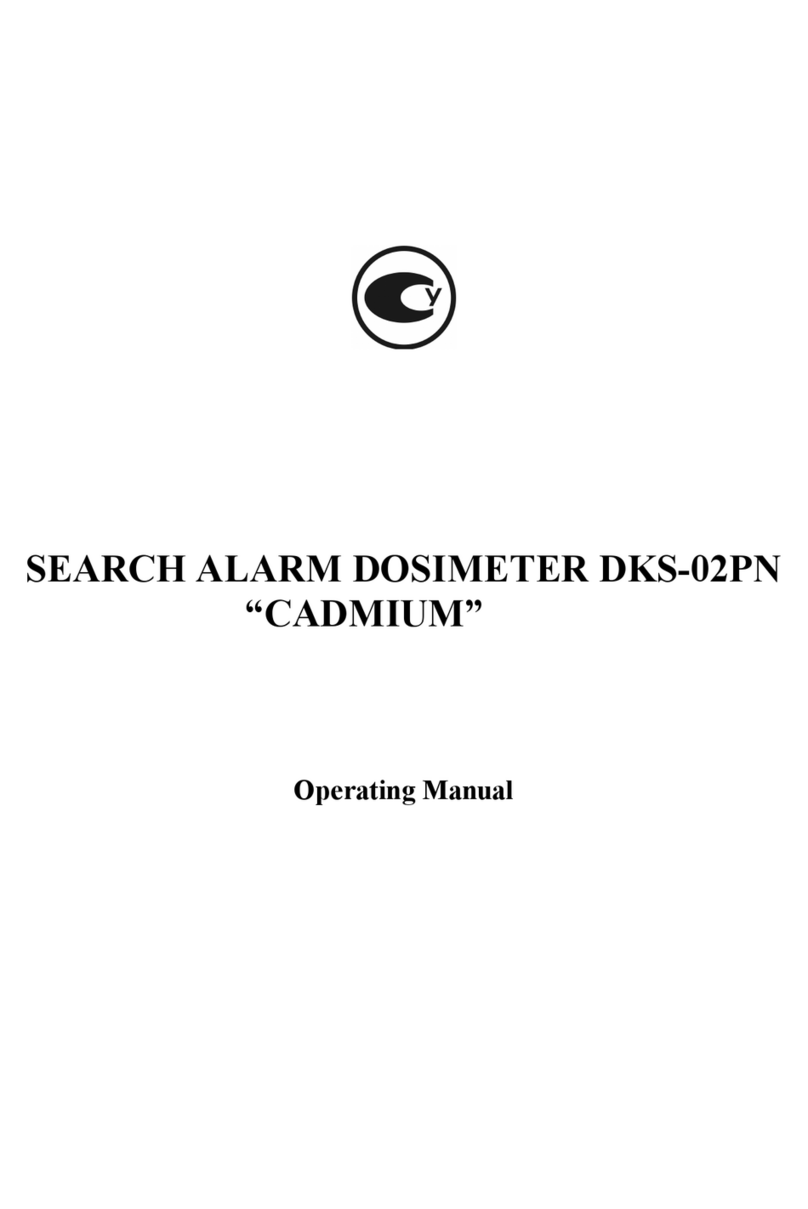
ECOTEST
ECOTEST DKS-02PN User manual
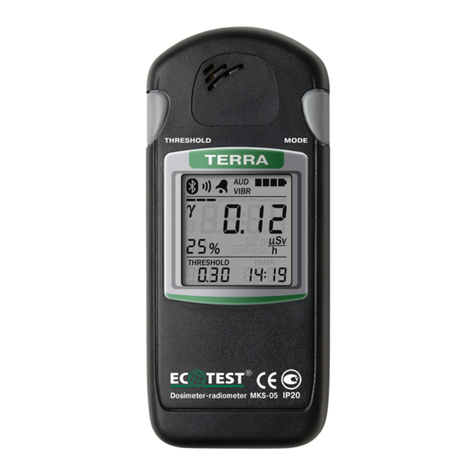
ECOTEST
ECOTEST MKS-05 TERRA User manual
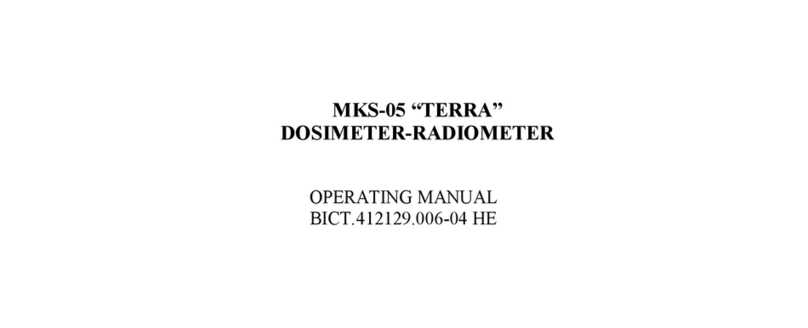
ECOTEST
ECOTEST MKS-05 TERRA User manual
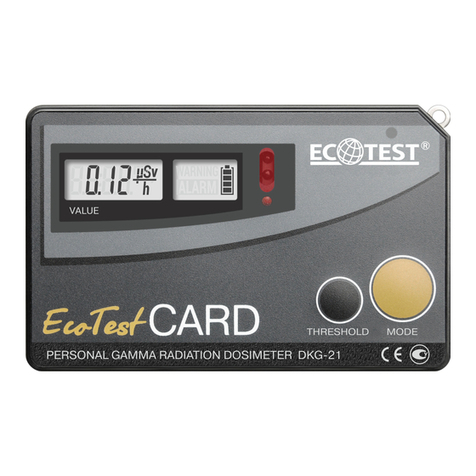
ECOTEST
ECOTEST DKG-21 User manual

ECOTEST
ECOTEST MKS-05 TERRA-P+ User manual
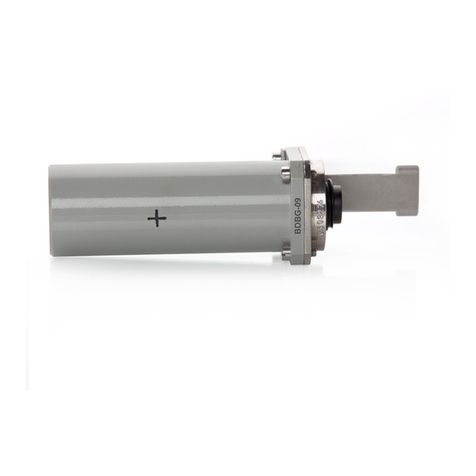
ECOTEST
ECOTEST BDBG-09 User manual
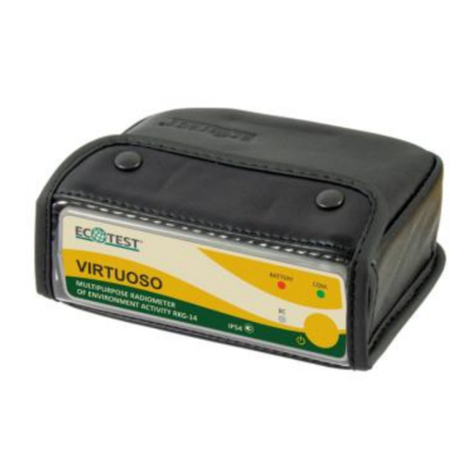
ECOTEST
ECOTEST VIRTUOSO RKG-14 User manual
Popular Measuring Instrument manuals by other brands
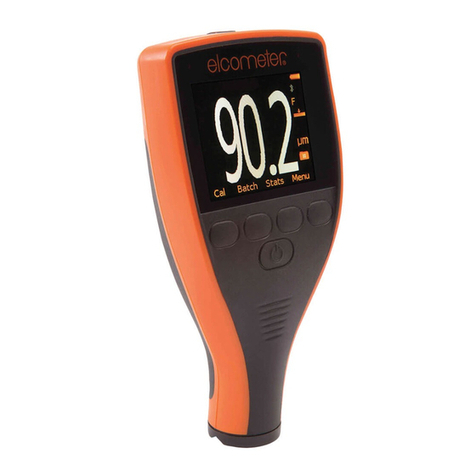
Elcometer
Elcometer 456 user guide

Leica Geosystems
Leica Geosystems Viva TPS Getting started guide
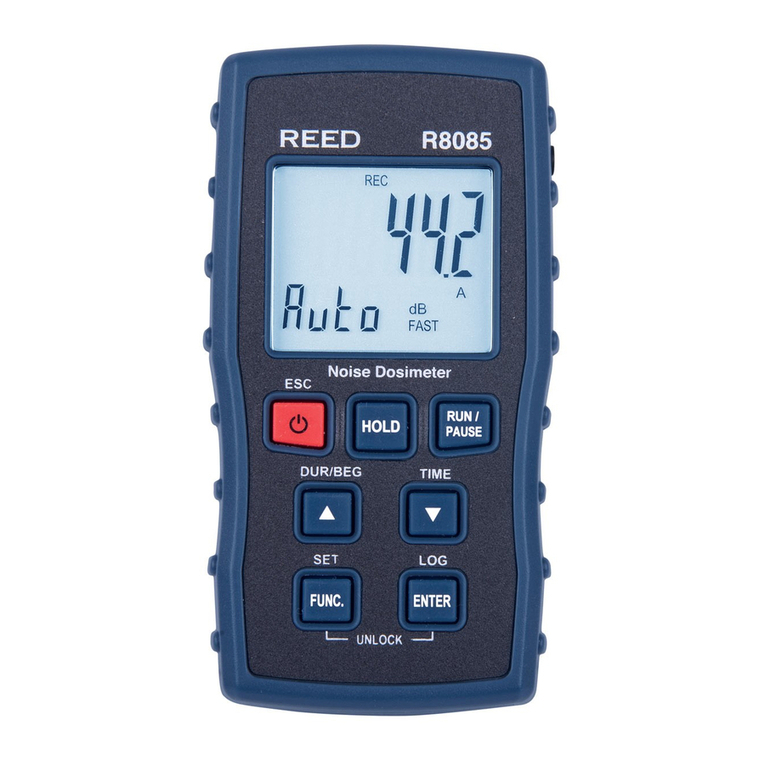
Reed Instruments
Reed Instruments R8085 instruction manual
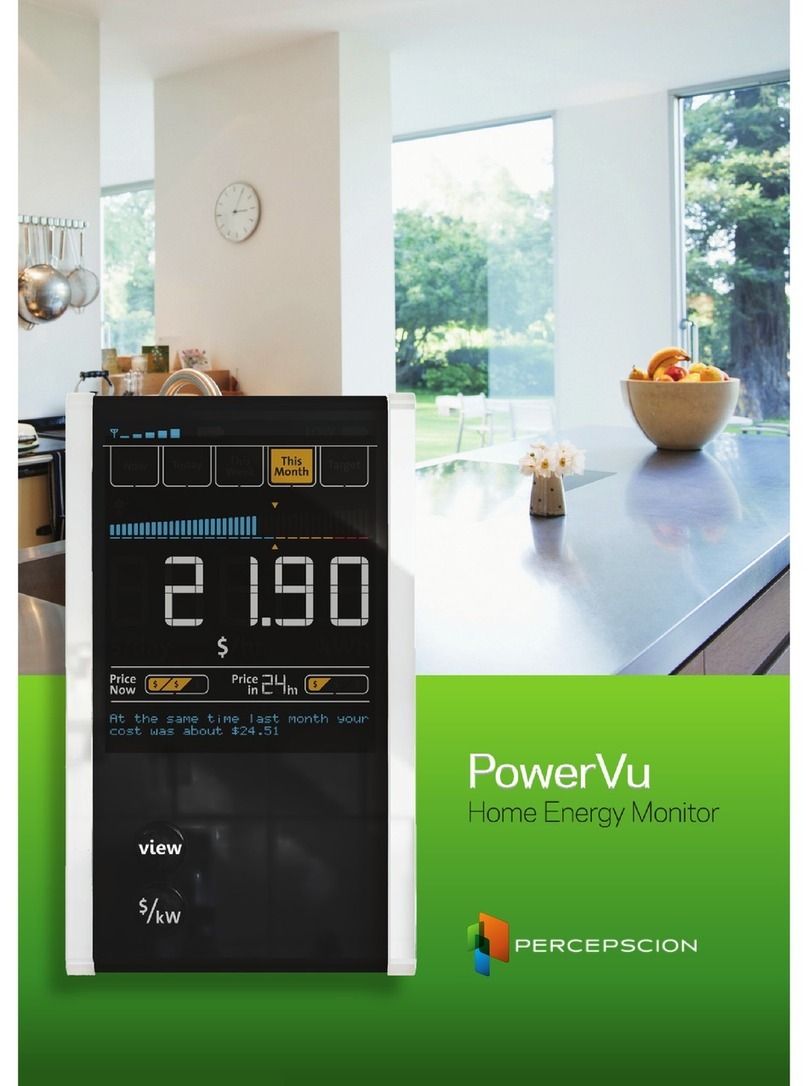
Perception
Perception PowerVu user manual
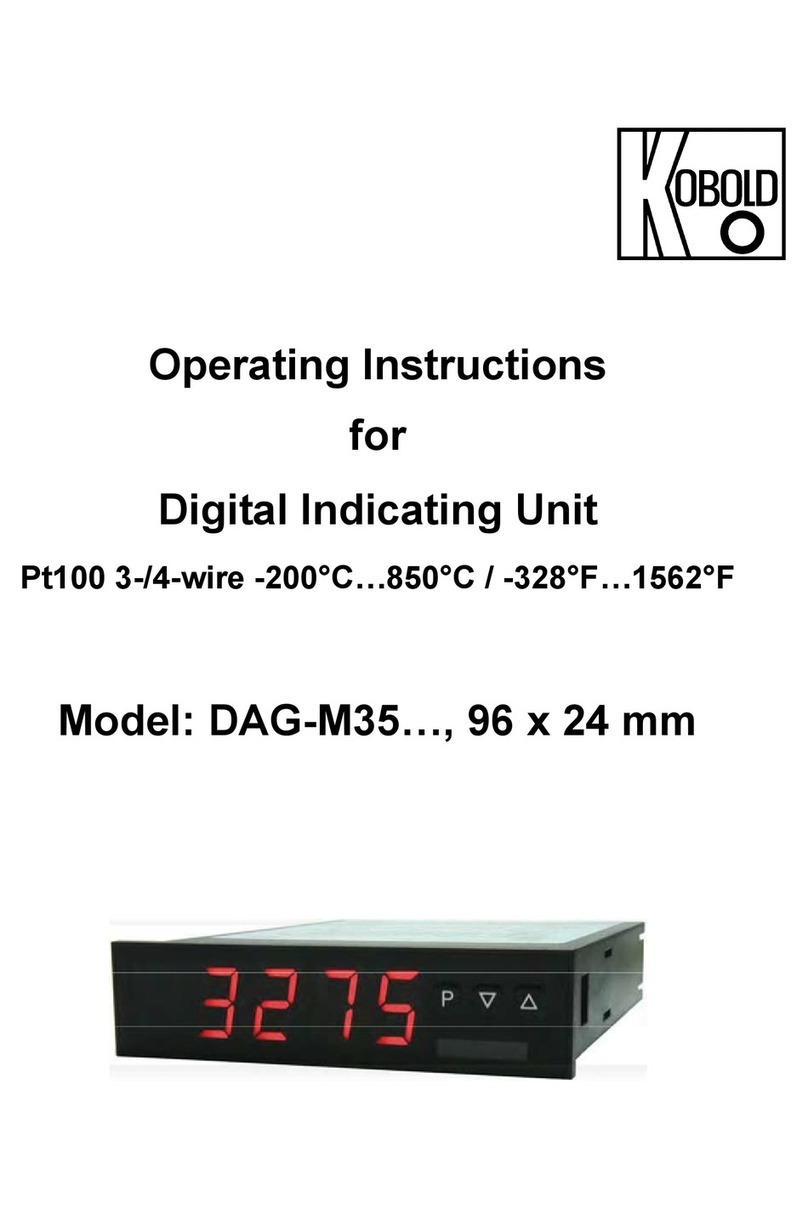
Kobold
Kobold DAG-M35 Series operating instructions
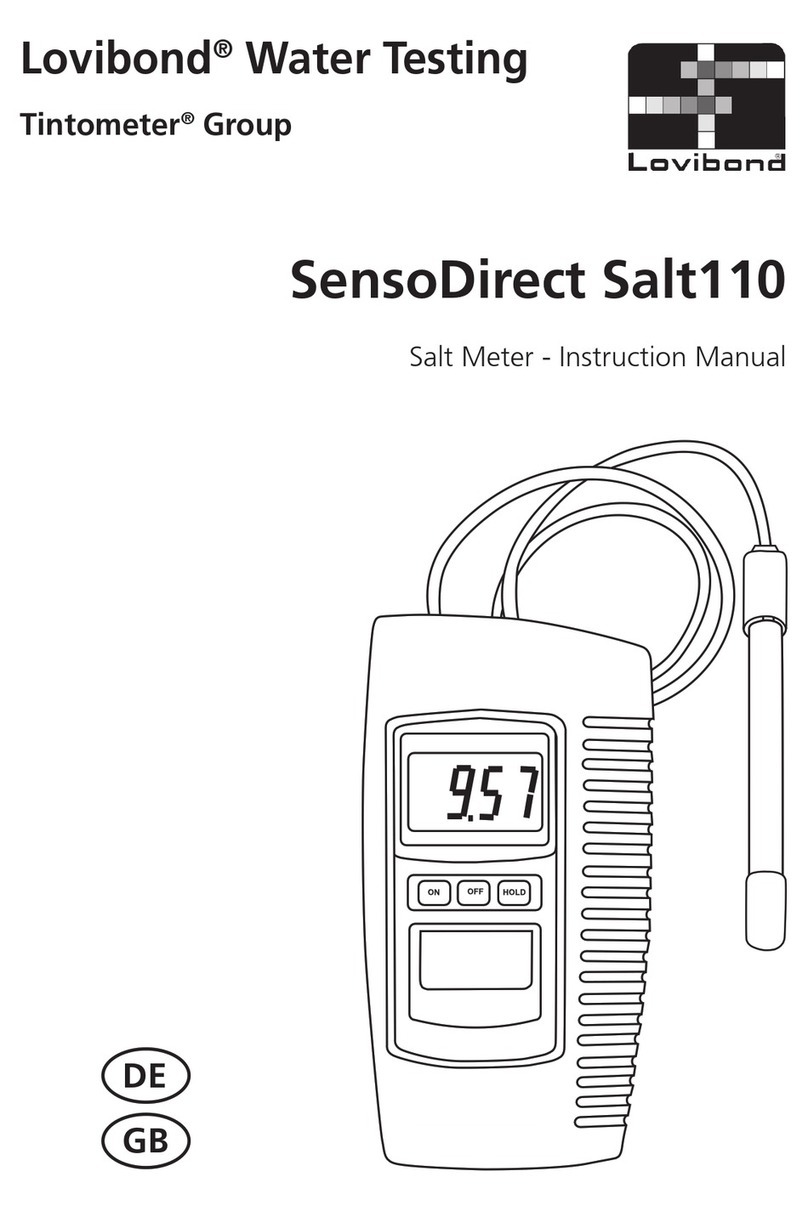
Lovibond
Lovibond Tintometer SensoDirect Salt110 instruction manual
